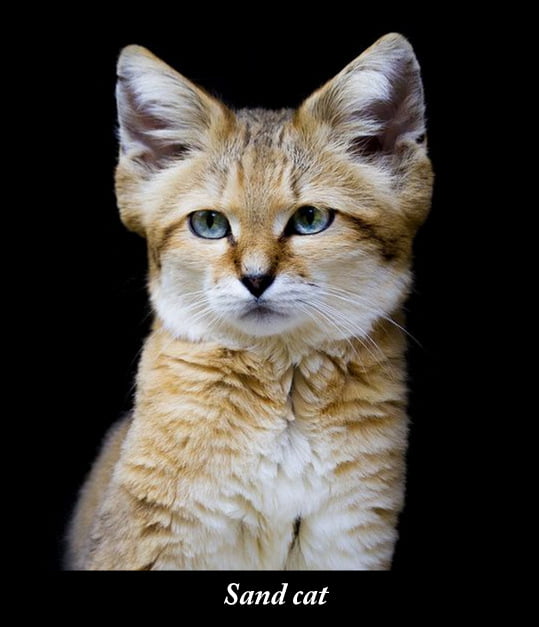
The sand cat copes with a wide variation in temperatures in its chosen habitat, the desert. For example, in the Karakum Desert (in Central Asia) temperatures can be higher than 40°C and the upper layer of the sand can rise to over 80°C, whereas in the winter the temperature can fall to as low as -25°C. One adaptation that the sand cat makes to deal with this extreme temperature range is to retreat to a burrow during the worst of the heat or cold. If and when it snows the cat has been known to stay in its burrow for several days. In addition, the sand cat has a thick coat which offers protection against the cold.
Further, the tufts of hair on its feet protect the paw pads from the baking heat of the sand and in addition make it easier for the cat to move through the fine sand.
Another adaptation is the sound cat’s huge ears and enlarged tympanic bullae. This allows the cat to rely heavily on its superb hearing to detect prey. Further, the ears are low set which enables the cat to take advantage of sparse cover while stalking prey.
The cat’s plain, pale and sand-coloured coat also helps to conceal them when hunting. The sand cat obtains nearly all of its water from eating prey. They can survive without freestanding water. Most of the year they do not drink. However, they will drink water when it is available.
With respect to prey, the sand cat is an opportunistic hunter that will eat whatever they can catch. They will take gerbils to geckos and birds to beetles. They may hunt all night starting a little before sunset or just as it becomes dark and sometimes extending their activities into the early morning. The sand cat will often travel long distances when searching for prey. In Israel, a study found that a radio-coloured male travelled 8 km during the night. The cat then returned to his burrow the following night. In another study a sand cat travelled an average of 5.4 km per night.
I’ve mentioned the sand cat’s burrow. Saharan nomads call the cat “the cat that digs holes”. The cat either makes its own burrow or occupies abandoned burrows of the red fox, corsac fox, Ruppels’s fox or porcupine. The cat will enlarge the burrows of gerbils and ground squirrels.
SOME MORE ON THE SAND CAT (please click on the links):

